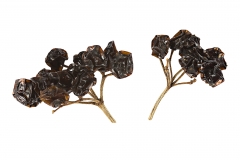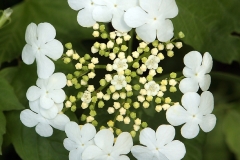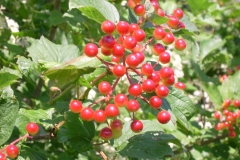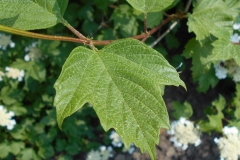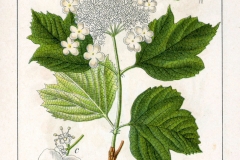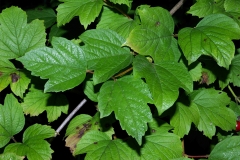| Guelder Rose Quick Facts | |
|---|---|
| Name: | Guelder Rose |
| Scientific Name: | Viburnum opulus |
| Origin | Native to Europe |
| Colors | Bright red |
| Shapes | Globose drupe, 7–10 mm diameter |
| Flesh colors | Yellowish |
| Taste | Astringent-bitter-sour |
| Name | Guelder rose |
|---|---|
| Scientific Name | Viburnum opulus |
| Native | Europe, northern Africa, northern Asia, it also grows well in the United States and Canada |
| Common Names | Guelder Rose, Cramp Bark, European cranberrybush, American cranberrybush, Crampbark, European Highb, American cranberry bush, Common snowball, Cranberry bush, Cranberry tree, Dagdagan, Gilaboru, Gilaburu, Gildar, Gilgili, High cranberry, Highbush cranberry, Pimbina, Snowball bush, Squaw bush |
| Name in Other Languages | Afrikaans: Gelderse roos Albanian: Guelder-rose, butinë Amharic: Guelder-rose Arabic: Airtafae (ارتفع) guelder-rose-airtafae guelder-rose, rubatiat darhamiat al’azhar (رباطية درهمية الأزهار) Armenian: Gvard-vard (գվարդ-վարդ), brrnch’i sovorakan (բռնչի սովորական) Azerbaijani: Guilder-gül, Adi başınağacı Azb: عادی باشین آغاجی Basque: Gaukar Belarusian: Kalina zvyčajnaja (Каліна звычайная) Bengali: Guelder Gōlāpa (গোলাপ),Guelder-gōlāpa Bulgarian: Kalina-roza (калина-роза), chervona kalina (червена калина) Burmese: Nhainnse (နှင်းဆီ), guelder- nhainnse Catalan: Aliguer, Boles de neu, Matoner, Matons, Mató de monja, Pom de neu, Saüc doble, saúc d’agua Chinese: Qióng huā (琼花), ou zhou jia mi Cornish: Skaw dowr Cree: Nepiminana Croatian: Guelder-ruža, obična udikovina, Kalina Czech: Guelder-rose, kalina obecná Danish: Guelder-rose, Almindelig kvalkved, Kvalkved, snebolletræ, Ulvsrøn Dutch: Gelderse roos, guelderse roos English: Guelder-rose, European cranberry bush, Crampbark, Viburnum, Cranberry viburnum, European cranberry viburnum, European cranberry-bush, European highbush cranberry, Snowball tree, Water elder, Gemeiner Schneeball, Schneeball, Highbush-Cranberry Esperanto: Guelder-rozo, Opulo Estonian: Guelder-rose, harilik lodjapuu, Hullukoeramarjapuu, Koerõispuu, Leedripuu, Lodjapuu, Oispuu Filipino: Guelder-rose Finnish: Guelder-rose, Koiranheisi, Lumipalloheisi, Lumipallopensas French: Guelder rose, Viorne obier, Obier, Viorne aquatique, aubier, bois à quenouilles, boule de neige, caillebot, charcoulier, sureau d’eau, Rosa de Gueldre, tose de Gueldre Galician: Flor do mundo Georgian: Guelder Vardi (ვარდი), guelder-vardi German: Guelder-Rose, Gemeiner Schneeball, Gewöhnlicher Schneeball, Drosselbeere, Greek: Triantáfyllo (τριαντάφυλλο) guelder-triantáfyllo guelder Gujarati: Gulḍara-gulāba (ગુલ્ડર-ગુલાબ) Hausa: Guelder-fure Hebrew: Gildn-urd (גילדן-ורד) Hindi: guladar gulaab (गुलदर गुलाब), Udvesta Chala Hungarian: Labdarózsa, kányabangita Icelandic: Guelder-rose Indonesian: Guelder-rose Irish: Guelder-rose, Rós Ollannach Italian: Rosa Viburno, ballon di neve, oppio, palle di neve, pallone di neve, sambuco acquatico, sambuco rosso, Japanese: Guerudārōzu (グエルダーローズ), Kanboku (カンボク) Javanese: Guelder-rose Kannada: Gulḍar-gulābi (ಗುಲ್ಡರ್-ಗುಲಾಬಿ) Kazakh: Gelder-rawşan (гельдер-раушан), Kädimgi şäñkiş (Кәдімгі шәңкіш) Korean: Guelder-rose Kurdish: Guelder-Rose Lao: Guelder-rose Latin: Viburnum rosa Latvian: Guelder-rose, parastā irbene Lithuanian: Guelder-rose, paprastasis putinas Livvi: Ruskei höydöipuu Macedonian: гелдер-роза-gelder-roza, калина, црвена калина Malagasy: Guelder-raozy Malay: Geram-naik Malayalam: Gulḍar-ṟēās (ഗുൽഡർ-റോസ്) Maltese: Rose-guelder Marathi: Guladar-gulaab (गुलडर-गुलाब) Mongolian: Gua-sarnai (гуа-сарнай) Nepali: Guledar-gulaab (गुलेडर-गुलाब) Norwegian: Guelder-rose, Korsved, Krossved Occitan: Mena d’atatièr, Mena de tatanièr Oriya: ଗୁଏଲର୍-ଗୋଲାପ | Pashto: ګلډر-ګلاب Persian: گلبرگ گل رز, بوداغ Polish: Guelder-rose, kalina koralowa Portugese: Rosa-bola, bola-de-neve, noveleiro, rosa-de-Gueldres, viburno, espirema, novelo, novelo cromatico, novelo da china Punjabi: ਗੁਲਾਦਰ-ਗੁਲਾਬ-Gulādara-gulāba Romanian: Guelder-rose Russian: Kalina obyknovenaâ, kalina (калина), kalina obyknovennaya (калина обыкновенная), Kalina krasnaya (Калина красная), Krasnaya kalina (Красная калина), Obyknovennaya kalina (Обыкновенная калина) Serbian: Guelder-rose (гуелдер-росе), crvena udika (црвена удика) Sindhi: محافظ-گلاب Sinhala: Gulḍar-rōsa (ගුල්ඩර්-රෝස) Slovak: Kalina obyčajná Slovenian: Guelder-rose, brogovita Spanish: Guelder-rose, Bola de nieve, Mundillo, Sauquillo, aspil, bola de oro, güelde, membrera, mundillos, rodela, rosa de Gueldres, sauco de agua, saúco rodel, aleluyou, barbatilla, borlones copo de neive, corcovanos, flor del mundo, gebre, geldre Sundanese: Kasir-acuk Swedish: Skogsolvon, Koiranheisi, Olvon, Ulvtry, snöbollsbuske, beinve, krossved, kvalkved, olgon, Tajik: ги-рифт-gi-rift Tamil: Guelder-rose Telugu: Guelder-rōj (Guelder-రోజ్) Thai: Guelder kuh̄lāb (Guelder กุหลาบ) Turkish: Kartopu-gül, gilaburu, Gilaboru Ukrainian: Kalyna-troyanda (калина-троянда), kalyna zvychayna (калина звичайна), Chervona kalyna (Червона калина) Urdu: گلڈر گلاب Uzbek: Gulchi-atirgul Vietnamese: Cây kim ngân hoa, Vót châu Âu Walloon: Sawou d’ aiwe, Sayou d aiwe Welsh: Rhosyn guilder, Gwifwrnwydd y gors Zulu: Isindindizela |
| Plant Growth Habit | Small, perennial, deciduous shrub |
| Growing Climates | Hedges, scrub and woodland, usually on damp soils |
| Soil | Easily grown in average, medium moisture, well-drained soil in full sun to part shade |
| Plant Size | 6.5-11.5 ft. (2-3.5 m) tall |
| Bark | Light grey to brown when mature |
| Leaf | Three pointed lobes and are coarsely toothed; 2-4 in. (5-10 cm) long. The leaf stalk has two glands at the base of the leaf |
| Flowering season | June to July |
| Flower | White flowers are held in 3-4 in. (7.5-10 cm) wide, flat-topped umbels. The individual flowers are tiny and five-petaled |
| Fruit Shape & Size | Nearly round drupe about 1/3 inch diameter with single large seed |
| Fruit Color | Bright red |
| Flesh Color | Yellowish |
| Plant Parts Used | Bark |
| Available Forms | Tea, liquid extracts, capsules |
| Taste | Bitter |
| Season | August to September |
| Health Benefits |
|
Leaves
Leaves are opposite, simple, 3-lobed and about 2 to 4 inches long. They are glossy dark green which turns to yellow-red or red-purple in the fall. Petiole is grooved and has round, raised glands near the base.
Flowers
The plant blooms flowers in June in clusters which are 2-3 inches across with outer ring of larger and sterile flowers. Flowers are hermaphrodite and self-fertile which means individual plant flowers can pollinate one another. Flowers are pollinated by wind and insects.
Fruit
Fruits are nearly round drupe about 1/3 inch diameter with single large seed, juicy, bright red and quite acid like cranberry. Seeds ripen from August to September. It produce fruit when reached at five years of age.
Health Benefits of Guelder Rose
1. Menstrual Cramps
In vitro studies, Guelder Eose block spasms of smooth muscle. It is used for menstrual cramps following PMS. It helps to soothe severe cramping associated with vomiting, nausea and sweaty chills. Boil 2 teaspoons of dried bark into a cup of water and then simmer for 10 to 15 minutes. Take this tea three times per day for cramps.
2. Endometriosis
Endometriosis is a condition in which the tissue that normally lines the inside of the uterus grows outside the uterus. Fruits are used for treating gynecological disorders such as painful periods as well as ovarian cysts.
3. Muscle Relaxant
Guelder Rose acts as a natural muscle relaxant. It provides relief from menstrual cramping due to its ability to halt smooth muscle spasms. It provides relief from muscle spasms and aches throughout body whether associated to physical exertion and PMS. Other side effects of NSAIDs are leg swelling, stomach pain, dizziness, headaches, kidney issues and high blood pressure.
4. Muscle Relaxant
Cramp bark has anti-spasmodic compounds effective for all other types of cramp in the body. It includes gastrointestinal, bronchial, genitourinary and skeletal muscle spasms. As a skeletal muscle relaxant, it is effective for leg cramps.
5. Nervous health
It restores parasympathetic and sympathetic balance in voluntary and involuntary muscle spasms of autonomic nervous system. The sympathetic controls fight and parasympathetic controls rest and digest-balance between these two systems is crucial for overall vibrant health. It ensures that adequate resources in right place and at right time.
6. Circulation
Guelder Rose has relaxant activities which allows for increase circulation and blood flow. Relaxed muscles work efficiently and improvement in blood flow supports elimination of waste products from the body. It has vasodilatory properties which widens blood vessels and allows blood to flow more easily and exerts positive effect on blood pressure.
7. Sedative
Guelder Rose is rich in valerenic acid which is related with sedative herb Valerian. It acts as anti-spasmodic and sedative. The mild sedative effect could be enhanced by combining with other hormone regulating and sedative herbs.
Traditional Uses and benefits of Guelder Rose
- Guelder rose is a powerful antispasmodic and is much used in the treatment of asthma, cramps and other conditions such as colic or painful menstruation.
- It is also used as a sedative remedy for nervous conditions.
- The bark is antispasmodic, astringent and sedative.
- The bark contains ‘scopoletin’, a coumarin that has a sedative affect on the uterus.
- A tea is used internally to relieve all types of spasms, including menstrual cramps, spasms after childbirth and threatened miscarriage.
- It is also used in the treatment of nervous complaints and debility.
- The leaves and fruits are antiscorbutic, emetic and laxative.
- A homeopathic remedy is made from the fresh bark.
- It is used in the treatment of menstrual pain and spasms after childbirth.
- An herbal supplement made from the shrub’s dried bark has traditionally been used to treat pain from muscle cramps, especially period cramps, although other parts of the plant may also offer benefits.
- The supplement shows promising potential to relieve pain and promote healthy kidney function, and emerging research suggests that it may offer many other benefits as well.
- Fermented fruit juice of European cranberry bush is useful for kidney disorders, menstrual and stomach cramps, hypertension, asthma, digestion problems, and the common cold.
- In the 19th century, cramp bark was adopted for treatment of stomach cramps and dysmenorrhea, and to prevent miscarriage.
- Cramp bark has been used in folk medicine for the prevention of miscarriage.
Ayurvedic Health benefits of Guelder Rose
- Difficult Menses: Powder the dried Viburnum Opulus. Boil 2 tablespoons of dried powder in a cup of water for l0-l5 minutes. Drink 2 to 3 times a day. OR: Add quarter teaspoon of Viburnum Opulus tincture in half a glass of water. Drink it 2 to 3 times a day. (Note: It is advised that do not take it during menses. Take this before and after a week of your menstrual period.)
- Gallstones: Grind dried Viburnum Opulus Bark. Prepare tea with half teaspoon powder in a cup of water. Take it 4 times a day.
- Angina: Prepare a decoction of the bark of Viburnum Opulus. Have it two times a day.
- Brain Stroke: Prepare an infusion of the bark of Viburnum Opulus. Have one cup once a day.
- Difficult Menses: Grind Viburnum Opulus, Wind Flower and Partridge Berry together. Take one teaspoon every day for 7 days.
- Carpal Tunnel Syndrome: Make a decoction of the Viburnum Opulus, St. John’s Wort, Wild yam. Take twice a day.
- Endometriosis: Grind dried root of Chaste berry, Echinacea, Wild yam, Viburnum Opulus in equal quantity. Take Raspberry leaves and Motherwort leaves in half quantity. Prepare a decoction. Strain. Drink one cup two times a day.
Culinary uses
- Fruits are used as a substitute for tea or coffee.
- Fruit can be consumed raw or cooked.
- It is used as a cranberry substitute in making, jellies, preserves etc.
- In Canada, the fruits are a popular substitute for cranberries.
- In Russia, Siberia, and the Ukraine, they are used in drinks, sauces, and cakes.
- In Turkey, the fermented fruit juice of European cranberry bush is known as “gilaburu”.
Other Facts
- A red dye is obtained from the fruit.
- An ink can be made from the dried berries.
- Plants can be grown as a tall hedge, they are rather bare in winter though.
- The wood can be used to make skewers.
Precautions
- Large quantities of the fruit can cause vomiting and diarrhea.
- Fruit is of very low or zero toxicity, it only causes mild upsets when eaten unripe or in large quantities.
- If you are pregnant or nursing, you should consult your healthcare provider before using cramp bark.
References:
https://www.itis.gov/servlet/SingleRpt/SingleRpt?search_topic=TSN&search_value=35270#null
https://pfaf.org/user/Plant.aspx?LatinName=Viburnum+opulus
https://botanical.com/botanical/mgmh/g/gueros44.html
https://en.wikipedia.org/wiki/Viburnum_opulus
https://extension.umaine.edu/cranberries/highbush-cranberry/
https://www.eatweeds.co.uk/guelder-rose-viburnum-opulus
https://draxe.com/nutrition/cramp-bark/
https://www.fs.usda.gov/naspf/sites/default/files/naspf/pdf/guelder_rose.pdf



